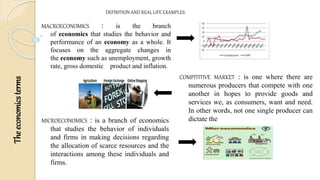
The economics terms (1)
- 1. The economics terms DEFINITION AND REAL LIFE EXAMPLES: MACROECONOMICS : is the branch of economics that studies the behavior and performance of an economy as a whole. It focuses on the aggregate changes in the economy such as unemployment, growth rate, gross domestic product and inflation. COMPITITIVE MARKET : is one where there are numerous producers that compete with one another in hopes to provide goods and services we, as consumers, want and need. In other words, not one single producer can dictate the MICROECONOMICS : is a branch of economics that studies the behavior of individuals and firms in making decisions regarding the allocation of scarce resources and the interactions among these individuals and firms.
- 2. COMMAND ECONOMY : is a system where the government, rather than the free market, determines what goods should be produced, how much should be produced, and the price at which the goods are offered for sale. It also determines investments and incomes. ABSOLUTE ADVANTAGE : is when a producer can produce a good or service in greater quantity for the same cost, or the same quantity at a lower cost, than other. OPPORTUNITY COST : the loss of other alternatives when one alternative is chosen. COMPARATIVE ADVANTAGE : is an economy's ability to produce a particular good or service at a lower opportunity cost than its trading partners. It gives a company the ability to sell goods and services at a lower price than its competitors and realize stronger sales margins.
- 3. DEMAND : is an economic principle referring to a consumer's desire to purchase goods and services and willingness to pay a price for a specific good or service. Holding all other factors constant, an increase in the price of a good or service will decrease the quantity demanded, and vice versa. SUPPLY : is a fundamental economic concept that describes the total amount of a specific good or service that is available to consumers. Supply can relate to the amount available at a specific price or the amount available across a range of prices if displayed on a graph. EXCESS SUPPLY : In economics, an excess supply or economic surplus is a situation in which the quantity of a good or service supplied is more than the quantity demanded, and the price is above the equilibrium level determined by supply and demand.
- 4. EXCESS DEMAND : is demand minus supply. SHIFT : a movement occurs when a change in quantity supplied is caused only by a change in price, and vice versa. Meanwhile, a shift in a demand or supply curve occurs when a good's quantity demanded or supplied changes even though price remains the same. ELASTIC DEMAND : is a fundamental economic concept that describes the total amount of a specific good or service that is available to consumers. Supply can relate to the amount available at a specific price or the amount available across a range of prices if displayed on a graph. ELASTIC SUPPLY : Price elasticity of supply measures the responsiveness to the supply of a good or service after a change in its market price. According to basic economic theory, the supply of a good will increase when its price rises. Elastic means the product is considered sensitive to price changes.
- 5. INELASTIC DEMAND : An example of an elastic good is movie tickets, which are viewed as entertainment and not a necessity. The price elasticity of supply is determined by: Number of producers: ease of entry into the market. Spare capacity: it is easy to increase production if there is a shift in demand. INELASTIC SUPPLY : Inelastic goods are often described as necessities. A shift in price does not drastically impact consumer demand or the overall supply of the good because it is not something people are able or willing to go without. LAW OF DIMINISHING RETURNS : Diminishing returns, also called law of diminishing returns or principle of diminishing marginal productivity, economic law stating that if one input in the production of a commodity is increased while all other inputs are held fixed, a point will eventually be reached at which additions of the input yield.
- 6. INFLATION : is the decline of purchasing power of a given currency over time. A quantitative estimate of the rate at which the decline in purchasing power occurs can be reflected in the increase of an average price level of a basket of selected goods and services in an economy over some period of time. INCENTIVE : In the most general terms, an incentive is anything that motivates a person to do something. When we're talking about economics, the definition becomes a bit narrower: Economic incentives are financial motivations for people to take certain actions. MONOPOLY : A market structure in which only one seller sells a product for which there are no close substitutes. Cartel. A formal organizations of sellers or producers that agree to act together to set prices and limit output. Price maker.
- 7. OLIGOPOLY : An oligopoly is a market characterized by a small number of firms who realize they are interdependent in their pricing and output policies. The number of firms is small enough to give each firm some market power. PRESENTEDBY : YEDAPALLY . SRUJANA REDDY 18031AA079 B - SECTION 6Th SEMESTER CSIIT SCHOOL OF PLANNING AND ARCHITECTURE HYDERABAD